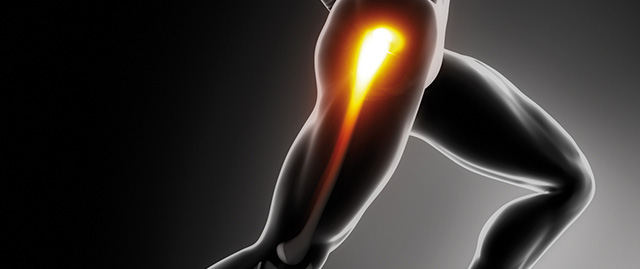You can count on our team at ORTHOmedic
to get you back on your feet in no time

Hip
The second largest joint in the human body is in a category of its own for one main reason: quality of life can be greatly reduced by diseases in this area. Hip pain can increasingly restrict mobility, causing patients to move unnatural ways, which often triggers further orthopaedic problems.
Incidentally, hip diseases are not necessarily a symptom of old age. On the contrary, early diagnosis can slow down excessive wear and any subsequent damage or prevent this entirely. For this reason, it is advisable to seek help for any pain caused by strain, for the sensation of any foreign bodies or difficulty making certain movements even from a younger age.
On this page you will find an overview of the most common hip problems and some examples of how these can be treated. Aside from artificial joint replacements, all operations are carried out via an arthroscopic procedure. ORTHOmedic is specialised in this minimally invasive procedure. Your expert for hip diseases here at ORTHOmedic is Professor Schofer.
Femoroacetabular impingement (FAI)
Hip impingement syndrome occurs when the femoral head and socket do not fit together properly. Protruding bones cause tendons and soft tissues to become trapped. Pain often occurs when sitting or bending, for example during a long car journey, during sport or when tying laces. Symptoms are often mistaken for symptoms of a hernia, urinary tract or abdominal disease. Hip impingement can be cured by removing the protruding bone by means of an arthroscopy.
Arthrosis and early arthrosis
Excessive wear can occur naturally with age or as a result of strain on the joints. Early symptoms include temporary pain induced by strain on the joint. Arthrosis occurs when the cartilage becomes worn and uneven, which leads to restricted mobility. If diagnosed early enough, damage to the cartilage can be treated by means of an arthroscopy. Possible treatment involves modelling the cartilage by means of a regenerative procedure or transplantation of cultured autologous tissue (the patient’s own tissue). If it is not possible to salvage the existing cartilage and the damaged bone, a modern endoprosthetics procedure may be carried out.
Loose bodies in the hip joint
This form of hip disease can best be explained using the analogy of sand in a gearbox: Fragments of bone and cartilage that have become loose as a result of excess strain or disease in the joint become trapped between the femoral head and the socket, hindering natural movement patterns and causing further damage to the joint. An arthroscopy can be carried out to carefully remove the fragments causing damage to the joint and to treat any damage already caused.
Chronic inflammation (trochanteric bursitis, synovitis, rheumatism)
Inflammation can occur as a result of overexertion during sport or in the workplace, but it can also be caused by autoimmune diseases which are not triggered by external factors. If left untreated, these can irritate the surrounding tissue, causing adhesion or hardening of this tissue, which can become painful. Inflammation of the hip joint can occur in the synovial bursa, joint capsules or joint mucosa. Medication may be administered to treat this, or if necessary, the centre of inflammation may be surgically removed.
Osteonecrosis of the femoral head
This serious disease is a type of bone infarction that occurs when part of the bone dies as a result of an interruption of blood supply. The cause of this phenomenon is uncertain. Early diagnosis of osteonecrosis is the most important factor in preventing gradual destruction of the bone and ultimately, a prosthesis. One possible form of treatment involves drilling a hole into the bone and stimulating new bone growth. In advanced cases of osteonecrosis, an endoprosthesis is usually required.
Coxa saltans (snapping hip syndrome)
This form of hip disease is not necessarily painful but is often unpleasant for sufferers. The main tendon in the hamstring muscle remains attached to the trochanter when bending or stretching before ‘snapping’ over. This snapping motion can be felt and sometimes even heard. Often physiotherapy is a sufficient form of treatment. However, in severe cases, the tendon may also be released or an incision may be made by means of an arthroscopy to temporarily stop the snapping motion from occurring.

